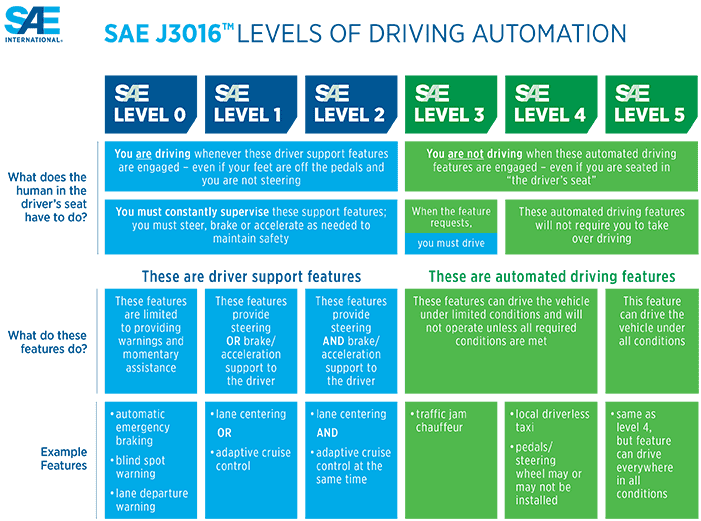UAM Autonomy: What It’s Going to Take

Autonomy is not automation. Consider this: We all want autonomy—the power to control our lives; none of us wants to be automated.
The Society of Automobile Engineers International (SAE) has defined six levels of autonomy, ranging from no automation (Level 0) to full automation (Level 5) for cars. These standards have been adopted by the U.S. Department of Transportation, which likely means the FAA and NASA will, if they haven’t already, take these standards into consideration when certifying eVTOLs, hybrid VTOLs, and other “flying cars” for civilian, military, and government use over U.S. airspace.
Six Degrees of Autonomy
The SAE has developed standards to help define varying degrees of automation, which, in turn, impact the amount of autonomy a vehicle has to govern its operations.
If you think autonomous-driving automobiles are complex (they are!), consider the challenges of fully autonomous flight, even just for conventional aircraft. In 2007, when Alan Mulally was transitioning from his job as CEO of Boeing Airplanes to CEO of Ford Motor Company, the giant automaker was on the verge of bankruptcy. A Ford manager asked the incoming leader, “How are you going to tackle something as complex and unfamiliar as the auto business when we are in such tough financial shape?” Mulally’s deadpan reply, “An automobile has about 10,000 moving parts, right? An airplane has two million, and it has to stay up in the air.” I got this, Mulally effectively said.
Today’s aircraft have autopilot functionality. But it’s only used when the plane has reached cruising altitude in a system overseen by air traffic regulators and pilots still in the cockpit. If tomorrow’s eVTOLs are going to be autonomous, whether for surveillance, cargo, or passenger transportation, a lot will have to happen first.
Six Elements of Automation Functionality
In a seminar presented by the USRA (Universities Space Research Association)-NASA-Berkeley Aviation Data Science at the Berkeley Institute for Data Science Dr. Ella Atkins, a professor of Aerospace Engineering at the University of Michigan, explained there are six elements essential to UAM automation functions: Perceive, Analyze and Decide, Warn/Inform/Act/Limit, and Integrate. Automation itself has four levels: No capability, limited, nominal, and comprehensive. Certifying components, Dr. Atkins, says, is comparatively easy; integrating them, putting them together, is hard.
There are two ways to get to advanced air mobility (AAM): The Piloted Aircraft Path or the Pilotless Path. Charting the simpler path, the Piloted Aircraft Path, might involve four phases:
1) Retrofit existing two-pilot aircraft. This adds a layer of safety and public acceptance.
2) Transition to Simplified Vehicles Operations (SVO). We have experience with this and can redefine pilot training accordingly.
3) Safety Pilot operations would involve operating the vehicle with a pilot remotely situated on the ground.
4) End State operations, where a supervisor maintains operational control over multiple aircraft.
To get to this fourth phase of the piloted path, Atkins posits that pilots will need more computer science knowledge and experience than they now have with stick-and-rudder operations.
Looking at the pilotless aircraft path, Dr. Atkins outlines a four-milestone approach:
- Initial R&D
- Operations in highly controlled environments without people on board (Operations Milestone)
- Operations in extreme conditions without people on board (Certification Milestone)
- Fully autonomous passenger operations—the [desired] End State. We will need redundancy, resiliency, and diversity [of circumstances.] These are the things, she says, that will get us to the level of safety we expect.
There will, however, likely need to be a flight attendant when people are on board to handle things, such as medical emergencies, that might arise mid-flight.
Other things can go wrong too. For example, Dr. Atkins asserts, there can be individual sub-system failures or a combination of sub-system failures. There can be cyber attacks on the datalink and communications systems. Personnel or equipment might experience outages. The vertiport or landing site might experience suboptimal conditions. Extreme weather conditions may challenge the aircraft. And, there may be unintentional system interactions or human-machine coordination errors that could cause problems during an autonomously operated flight. That doesn’t even begin to address what happens when swarms of drones are operational.
Expecting the Unexpected in Autonomous Flight
For autonomous flight to succeed, the research needs to include a focus on nominal events, such as an in-flight emergency and, on how and what, will trigger autonomy override—a prospect that takes into account envelope-aware flight management when there are boundary violations or loss of control is imminent. These nominal events might require operational changes, such as speed or altitude, or even a change in the planned destination.
The way to plan for these types of events, Dr. Atkins explained, is for there to be sensor-data fusion when landing decisions are involved. This will require the input of traditional metrics, such as mission time and energy use, but also the metrics generated by sensor-data fusion, such as risk during overflight and landing, obstacles, or thermal and power management onboard.
Data will come from LIDAR, geographic information systems (GIS) and open street maps (OSM), a Census Cell, and the terrain itself. It will be processed and the options analyzed for risk. Taking into account the data the system acquires (including road traffic, bridges, and power lines, for example), an emergency landing site (including rooftops) might be formulated for urban air vehicles.
UAM Flier Beware (of Everything)
Dr. Atkins sums it up best: “Urban air mobility (UAM) can only be achieved at scale when emerging eVTOL operations are safe despite reduced pilot training requirements. Traditional sensor data can be augmented with new cloud resources, such as roadmaps and geographical information systems (GIS) LIDAR/video, to offer emerging unmanned aircraft systems (UAS) and UAM operations a new level of situational awareness.”
Want to continue to stay up-to-date about the latest developments in the eVTOL industry? Subscribe to AeroCar Journal now. It’s FREE (for a limited time)! Join us on Twitter for the latest news, analysis, and insight about the eVTOL industry. AeroCarJ


